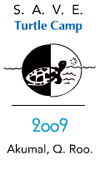Contact us at Fax/Phone. 52 (984) 87 59020 & 87 59021.Now from U.S.A. Toll Free Number. 1-866-619-9050.
© Copyright 2008 S.A.V.E Akumal, Quintana Roo. México. 2008
What Is S.A.V.E.
The descriotion of our ONG, our mission and projects
S.A.V.E.
Saving the future for next generations
 With the coming of 2008, more hotels, and more permissions for building in general being granted, we are concerned with several aspects of major environmental importance at present in the Yucatan Peninsula, some issues we are addressing at the moment the following, which are:
With the coming of 2008, more hotels, and more permissions for building in general being granted, we are concerned with several aspects of major environmental importance at present in the Yucatan Peninsula, some issues we are addressing at the moment the following, which are:
Turtles
Mangrove
Mesoamerican Reef Ecosystem
Bats
S.A.V.E. (Society of Akumal Vital Ecology), a grassroots organization, is located in the Caribbean Coastline State of Quintana Roo, Mexico on the beach that is known as the second largest turtle nesting beach on the Yucatan Peninsula, Aventuras Akumal. Just three miles to our south lies Xcacel Beach which can boast annually the most turtle nests on the Yucatan Peninsula.
As all marine turtles are endangered species (according with the Mexican Norm, la NOMSEMARNAT-059-2001 Ap. I CITES), it is important that observational data is compiled in order to assess the state of the turtle population.
Human activities that are currently threatening marine turtle’s subsistence are: the invasion of the beaches by tourist complexes, beach and water toys lining the coastline, beach walls, brightly lighted beach areas, petroleum extractions, and floating plastics.
Our hope is that the research compiled will lead to increased protective measures benefiting turtles, and in turn, the reef ecosystem.
What we do
SAVE is working towards improving the conditions on the Riviera Maya Coastline. The Turtle Protection Program that we have created operates annually in one year cycles focusing on green turtles and loggerhead turtles.
The observation time is during the eight month turtle nesting period. It is followed by four months of data processing preparation for the next nesting season. Because of the heavy development here, there is rampant overcrowding when the turtles make their nests.
Turtles are known to build nests on top of other nests, so there is occasionally some relocation of the eggs involved. We set up a hatchery and try to release the turtles as close to the original nest as possible when the eggs hatch. Often times turtles must be collected and released during the times when they hatch and head for the light of the condos instead of going toward the ocean.
The myth that turtles have an inborn sense of where the water is is simply not true, and because only one in a hundred turtles survive that are hatched, it is imperitive that baby turtles expend their energy in the water and not on the beach. An extremely important part of the turtle program is the educational aspect of it.
We send biologists to the local area schools to educate the kids about turtles and the importance of protecting mangroves. This is done semi annually and is becoming a highlight in the childrens curiculum. We have created a coloring book about the mangroves that is circulated amongst the kids, describing the mangrove filtration process and its importance to the reef.
All of this takes a lot of effort. Biologists and volunteers stay up all night observing and redirecting the tutles. There are turtle watches every night of the turtle season starting the last week of March and continuing until the second week of November (the last two months of the season are just to check the hatchings, no more turtles moms).The type of data that is gathered consists of; species identification, turtle measurements (length and width), egg counts, counts of dead turtles in nests, counts of eggs that are dead, counts of turtles on the surface, etc.
We would like to include the bats into the educational program we have created. Fear of bats is prevalent here and their cause might be greatly helped simply with just a little positive education. Also on our agenda for the bats is the building of bat houses to help replace some of the habitat that has been destroyed.
There are two options for this, we can order the bat houses, or we can build them. We prefer the latter because we are in favor of creating bat houses that are larger than the ones we found while researching the bats. The bats here live in large groups so small bat houses don't make sense. There is ample space on roof tops and other areas for the houses to be located within reach of the coastline, we just have to put the houses there.
As you can see, we are well under way in our efforts to help the Akumal area. There is much support here, albeit not so much from the Mexican government, but funding is always an issue. We have the means to immediately manifest the potential benefits created by any money we receive or volunteers that want to help.
 Turtle Camp 2008
Turtle Camp 2008
Join us to spend your summer learning about the turtles.
 Coastal Clean-Up
Coastal Clean-Up
Coastal Cleanup Day is an event where local school children and SAVE. (Society of Akumal’s Vital Ecology) work together and comb the beaches in search of reasons why trash was left behind. These day projects can be organized throughout the year.



